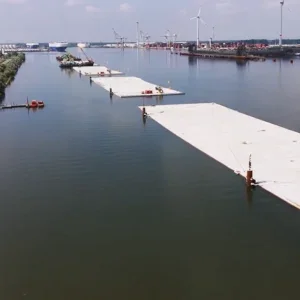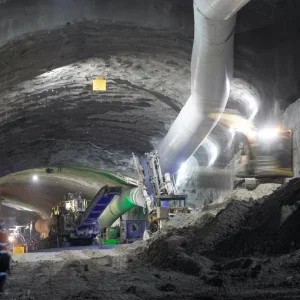The busy streets of downtown Los Angeles not only comprise the many offices, shops and restaurants that draw in transit users day to day, but have also seen the local population double in the last 20 years.
This same area is the center of the Los Angeles County Metropolitan Transportation Authority’s (Metro) network of public transit, which is steadily growing, buiding more miles of rail lines above and below ground each year. One in particular, the Regional Connector Transit Project, will do just as its name implies. Approximately two miles of underground light rail tunnel will connect the Blue, Expo and Gold Lines in the city’s downtown and add three new stations.
The rail line is expected to serve 88,000 riders daily – including 17,000 new riders – and save commuters up to 20 minutes by reducing the need to transfer when traveling to and through downtown L.A. Construction work is being delivered by the Regional Connector Constructors (RCC), led by Skanska On January 16, Metro and RCC celebrated a major milestone in the project with the final breakthrough of the TBM for the approximately 1-mile (1.6km) long twin tunnels. “Transforming the L.A. region through an aggressive transportation initiative has taken a giant step forward today,” said Metro CEO Phillip Washington. “When completed, this project will be a real game changer for the entire region by connecting three light rail lines that together have more than 180,000 boardings every weekday. Riders on the Metro Blue, Gold and Expo lines will reap the benefits of this project for generations to come.”
In addition to the challenges of building transportation infrastructure in an urban environment this particular tunnel had a relatively shallow alignment. The contract specified an EPB machine for which RCC chose to use a rebuilt and certified-new Herrenknecht TBM, 21.6ft (6.5m) in diameter, that had previously been used on L.A.’s East Side Gold Line project more than 10 years ago. Coincidentally, RCC launched the TBM where the new connection would eventually tie into the Gold Line, which was at grade and therefore in fairly shallow cover, as well as in alluvial ground conditions.
“Prior to starting mining the greatest concern was always launching in low cover in the sands,” says Mike Smith, a senior vice president with Skanska, and project director for RCC. “There was mandated compensation grouting by Metro. We also confirmed that with our designers. We put all those facilities in the ground to monitor and perform compensation grouting if required.”
Immediately after the launch the alignment passes under private property and through alluvium ground before transitioning to the Fernando Formation, a really weak siltstone good for mining. “We had very minimal movement, ground loses, even in the alluvial,” Smith says. “During mining we did not have to perform any compensation grouting because the guys were able to control the face so well.”
RCC used the one TBM for both twin tunnels, pulling the machine back through for reassembly and launch of the second drive. With a slight learning curve in the first drive, the contractor had a better idea on the second drive how the sand would behave. According Smith the first tunnel drive had around a 50ft (15m) per day average, and for the second it was closer to 70ft (21m).
“It’s good control of the machine, good operators, good supervision, really keeping control of the ground, and knowing what you’re in and knowing when things change—that’s really the key to our success,” he says of the tunnelling drives. Though the project was not without unforeseen challenges. “We encountered a soldier pile from what we believe is a previous excavation support system. We were able to make it through,” he says, but not without damaging the machine, including the screws and the face tools.
“Then coming down Flower Street, toward the end of the first drive we also encountered approximately 50 tie backs that we weren’t expecting. We fought our way through it.” Smith describes the repair work to enable the machine to finish the drive.
“We had to replace almost the entire face of cutting tools initially. One of main drive screws for the EPB ended up being damaged and sheered before we made it to our second station— that had to be field repaired and then it failed again on our last reach down Flower Street. Essentially we just field repaired, and nursed it through on the first drive.”
Gary Baker, project director for Metro, adds, “I think that was a huge success that those operators were able to nurse the machine through those obstacles. We had some damage to the machine but it didn’t stop the project. We’re very happy with how that turned out.”
Skanska and Traylor with Shea also have Metro’s West Side Subway Contract 1, which is using two Herrenknecht TBMs. As RCC prepared for the second drive, Smith explains, both of those TBMs were being factory tested in Germany. “Luckily we were able to pull the screws out of one of those machines, modify them slightly and installed the new screws on the second drive as an insurance policy to make sure that the repairs held.” Another accomplishment Baker highlights is preparation for and crossing under the existing Red Line tunnels within 5ft (1.5m) of the operating systems without interruption and with very negligible ground movement.
This final breakthrough brings the project to a near 50 per cent completion mark. RCC is now beginning to disassemble machine and concentrate on the remaining concrete and station construction on project.







